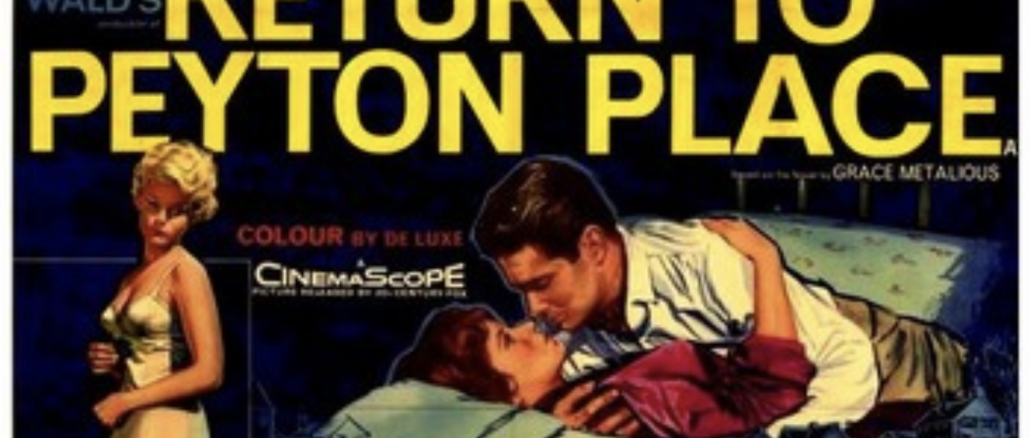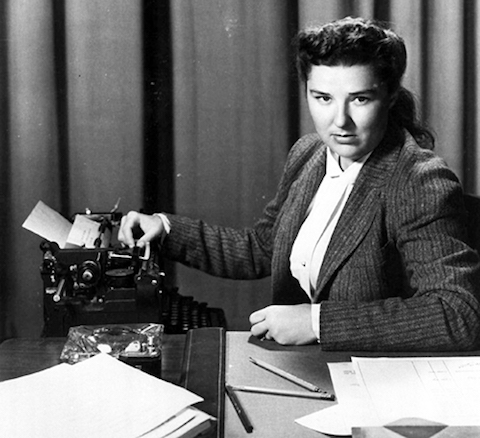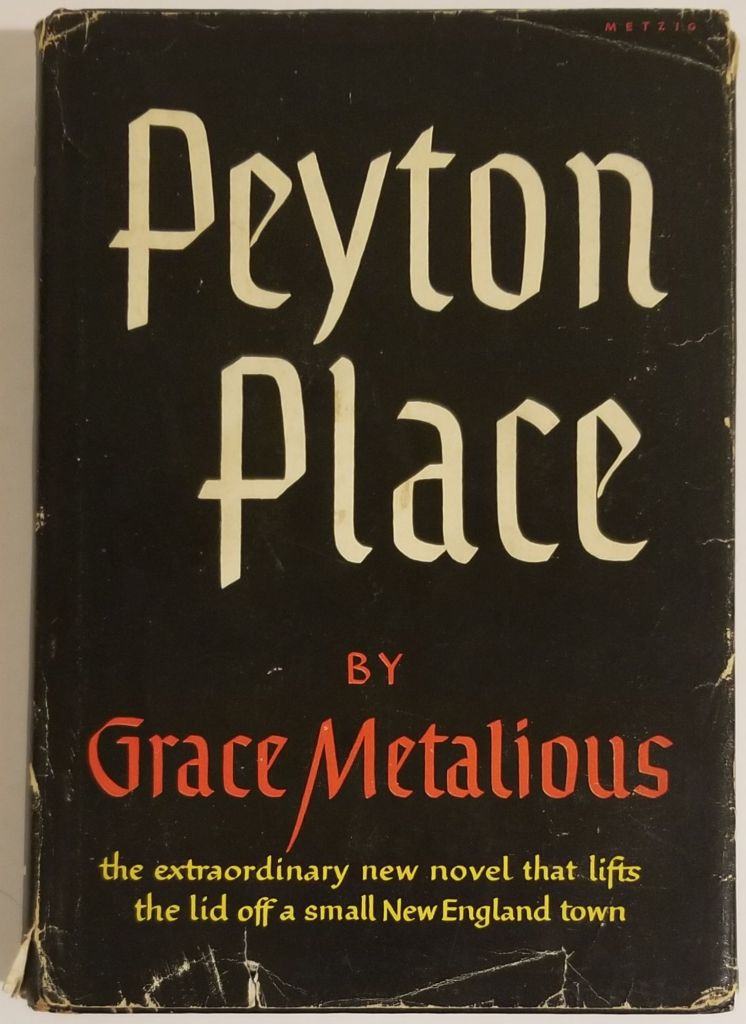
Article by Cult Film Alley
The portrayal of sex both in novels and onscreen was changed by author Grace Metalious and her Peyton Place books and the movies they spawned. Sadly, for the author the issue of malicious small-town gossip would consume her and continues to destroy lives to this day in the media and social media. Read also how 1940s actress Mary Astor triumphs over her true life gossip-filled past with her role in Return to Peyton Place…
*contains spoilers
Was writer Grace Metalious (1924-64 cirrhosis) some sort of genius or was it the screenwriters which helped to make the movies based on her novels Peyton Place (1957) and Return to Peyton Place (1961) such memorable experiences which sit together with some kind of trashy perfection?
They are not great movies, but in a way, both are landmarks in terms of popularity and possible milestones in book and movie censorship. The first book was published in 1956, and its frank depiction and description of sex caused it to be a publishing sensation and the biggest best-seller in the United States since Margaret Mitchell’s (1900-49 hit by a car) Gone with the Wind was published in the mid-1930s.


Of course, the movie version of Peyton Place followed quickly afterwards despite the sex and swearing being totally bowdlerised and yet its success at the box office saw the rights for the sequel Return to Peyton Place snapped up for a reported half a million dollars even before it was written.
However, poor Grace Metalious was destroyed by her own creation – success didn’t necessarily go to her head, but this girl who was born into a dirt-poor family who tolerated her scribblings as a child as she sat for long stretches in the bathtub, couldn’t handle the sudden riches the success of these books brought and an addiction to alcohol saw her only produce a few more novels before her untimely death from cirrhosis.
It was producer and four- time Oscar nominee Jerry Wald (1911-62 heart attack) who helped bring the first movie to the screen and it starred Lana Turner (1921-95 throat cancer) who scored the only Oscar nomination of her career. In fact, the movie was nominated for nine Oscars but won none, possibly because of Lana’s association with mobster Johnny Stompanato (1925-58 stabbed to death) who was later murdered by Lana’s daughter Cheryl (1943-) after an argument between Lana and himself over attending the Oscars where she was nominated… and also because the film was based on material which was still unmentionable in the movies and yet with its portrayal of rape, child abuse and abortion possibly led a curious audience to see how it would be handled on screen.


To nominate the film at all was perhaps an acknowledgement of the way tinsel-town was headed in terms of racy material but it was still unacceptable for it to be embraced fully by Oscar … especially in a year where the United States faced its past and present relationship with Japan with films like Bridge on the River Kwai (1957) and Sayonara (1957) which instead won the major awards. Peyton Place tied for many years as the film to be nominated for the most Oscars but not win a single one. But award shows be damned.
The murder of Stompanato saw box office receipts soar for Peyton Place and the sequel was hastily churned out by Metalious and ran one hundred pages shorter than the original book. Poor Metalious received critical scorn for both her books which were essentially lifting the lid on the sexual mores and secrets of a small American town as it also addressed the rites of passage of the innocent as they faced gossip and hypocrisy amid many of the town’s elders. It heralded a new generation which was not hung up on the word ‘sex’.


The original novel and its sequel and both movies followed the friendship between the characters of Allison MacKenzie who narrates and eventually writes the novel Peyton Place and Selena Cross who hides a terrible secret – her step-father raped her and made her pregnant and she had an “assisted miscarriage” as it is called in the movie as the word and idea of legal abortion was still something abhorrent to society of the day and even to some today. Thus, this poor girl is stigmatised and in the second book suffers from Post-Traumatic Stress disorder or mental illness which affects her relationship with men. While at the end of the original novel she was accepted following being acquitted of murdering her step-father, she was still, in a way, ostracised, and she knew it.
It is said Metalious was more like the Selena Cross character than Allison in terms of the poverty she grew up in. Her original French surname of Derepetigny helped her secure her first agent who also had the French name of Jacques Chambrun (1906-76). It is said that he ripped Metalious off financially in the end while she squandered the rest of her fortune, often giving it away. However, unlike it is portrayed in Return to Peyton Place, the author’s talent for hypnotising and shocking great swathes of the nation was discovered by two women and not a male publisher.


Leona Nevler (1926-2005 pulmonary embolism after surgery) read the unsolicited manuscript and upon it being passed by her company told Kitty Messner (no info) of the Julian Messner firm and Chambrun was contacted and a star was born. They recognised something frank and even beautiful as well as something incredibly feminist about Grace Metalious’s work. Author and agent would toast at New York restaurant 21 over a green daiquiri and one of Metalious’s best friends said she would “never be so poor or happy again”.
Despite the glossiness with which the first movie is presented and the fact it is possibly the better movie, the sequel Return to Peyton Place is the more strikingly enjoyable experience thanks mainly to its low-key casting, except for the roles played by Mary Astor (1906-87 respiratory failure and emphysema) and Jeff Chandler (1918-61 blood poisoning after surgery), and perhaps Carol Lynley (1942-2019 heart attack) as Allison.


Astor is so good in this movie that you would have expected her to win an Oscar nomination, while for Chandler, the film would only be in release for a week before his fateful back operation which led to his untimely death a month or so later. There was a malpractice suit. But, sadly, Return to Peyton Place was seen as little more than a sequel and based on an already trashy original – so Astor’s incredible work was ignored and she retired shortly afterwards, perhaps hurt, after appearing in only two more movies.
The first movie had been a straight and strait-jacketed re-telling of the original book while the sequel tells of how Allison comes to write the original book, ends up going to New York and gets it published… Then there is the fallout of the book’s effect upon Peyton Place itself and the people there along with Allison’s family and Selena Cross in the wake of its publication.
Let me just mention the climax of the first movie where the town’s doctor, played by Lloyd Nolan (1902-95 lung cancer), who helped the character of Selena lose her baby, testifies in court during Selena’s trial for murder as he tells the gathered township: “We’re all prisoners of each other’s gossip, killed by each other’s whispers.” It would seem the good people of Peyton Place needed a ‘dirty’ book like the book Metalious wrote to short circuit their own repressed desires and the absence or ability for gratification which is instead expressed through the de facto art of gossip and the feeling of moral detachment and superiority that gossip gives them. This is a part of the genius of Metalious and screenwriter John Michael Hayes’s (1919-2008) work, especially in the climax of Peyton Place – a feat which was achieved again, and possibly even eclipsed, in the sequel.


Nolan says Peyton Place has half a dozen churches but its attendees “then don’t practise a word they speak once they walk down the steps…” while “our indifference and failure as a community, to watch after one another and to know who need help and to give it” shows the white-anting of a community by hearsay which promotes an almost cunning self-service and interest instead of what was once known as true universal Christian values. Despite the fact we know there is no synagogue or mosque in Peyton Place, the movie shows the problems within the community will never be solved – it’s a worldwide social dilemma that made the book so popular in the first place. Further, in the sequel’s climax, it shows that the permissive society, which some say kicked off at the start of World War Two when the original movie was set, may be to blame for the breakdown of society and perhaps offers no real alternative. It is this tension which marks these movies for cult status. And forgive me if I seem myself to gossip about the dead in my articles!
The beginning of the original movie sets up Selena as a girl from the wrong side of the tracks and a town at the crossroads with a train crossing and Selena’s broken-down home shown in the establishing shots after the credits. It shows a town already being out of touch with the reality of poverty and hiding secrets in an era which will soon take its young men away to World War Two in a wake-up call for the world concerning Fascism beyond the façade of Americana. Peyton Place is set in 1941 on the eve of America’s entry into World War Two, which is perhaps another reason why the Japanese themed movies won the Oscars that year. Director Mark Robson (1913-78 heart attack) had worked on Val Lewton (1904-51 heart attacks) movies and his glossy treatment of trash was repeated controversially again with author Jacqueline Susann’s (1918-72 lung and breast cancer) Valley of the Dolls (1967).


Producer Jerry Wald (1911-62 heart attack) must have worked himself to death and in the wake of Return to Peyton Place died a year later. He believed in the sequel but none of the original cast returned as most were busy with subsequent successes and only he, and music composer Franz Waxman (1906-67 cancer), seem to be involved from the original production.
It is Waxman’s musical theme used in the first movie which has lyrics added by Paul Francis Webster (1907-84), who went on to write the original Spiderman theme in 1967. The song is called The Wonderful Season of Love and was sung by Rosemary Clooney (1928-2002 lung cancer) at the beginning of Return to Peyton Place and the film itself was directed by her then husband and feted stage and screen actor Jose Ferrer (1912-92 colorectal cancer).
We are shown by the opening shots of Return to Peyton Place that little has changed in Peyton Place although the action seems to be set in the present day of around 1961. The closing shot from the original movie of a young boy and girl riding their bicycles down a semi-rural street and the same shot is repeated in the opening montage of the sequel along with a couple of shots of wintertime snow covered branches and the blossoms which follow in spring… There is a kind of continuity but it is another era altogether – yet nothing changes and we are still watching the first movie but with a different point of view. The town is almost in some sort of time warp in terms of its warped reality.


We learn from the start that Peyton Place is somewhere that outsiders, or those who dare to be different, are tortured from the outset… this is alluded to when Allison is waiting for a call and the town’s exchange operator needlessly calls her home just to let her down with the news that she is just testing the phone line… It’s as if the call will never come…. And speaking of coming… Allison wants the publisher to come to Peyton Place rather than she coming to New York which plays a part in the loss of Allison’s innocence and her sexual awakening as well as her blossoming talents – all happening far away from Peyton Place. The return isn’t necessarily because this is a sequel but it is Allison’s return to Peyton Place which causes trouble for all involved and the reason it is recorded in terms of the town’s unofficial history as Metalious’s written sequel itself.
The question of Allison being a ‘legitimate’ author through publication is important, as we learn in the first movie, she is an illegitimate child, and publication to Allison – like many authors, I guess – would make her feel all the more legitimate within herself, if not the ‘legitimacy’ it would bring to her within the community of Peyton Place which she possibly truly desired. It is the kernel of her genius and it drives her, at least in the beginning, before the white anting by those upon her ‘return’. Return to Peyton Place is a part of a continuing era where illegitimacy of the individual is confirmed in terms of negative gossip. It is something which continues today and is contrasted by the pursuit of popularity and riches as being seen as the only true form of respectability and legitimacy in terms of the mass media and thus as a part of ‘society’ as a whole… the reverse is infamy…



The popularity which ensued the publication of Peyton Place destroyed the book’s original author Grace Metalious and this is hinted at in the coda of the movie sequel. The debate about the power of mass media is taken to the max in the debate at the end of the film just before that coda and showed that Metalious’s legitimacy may have been only on the surface in terms of best-selling figures, while the type of home town where she grew up, and which inspired the book, still conspired against, and to not accept her as one of their own in her lifetime. She had looked for the meaning of success within herself as approval by these people – that small town ‘home’ – and the true legitimacy of her genius as a writer and this misplaced notion ultimately destroyed her. It happens every day on a smaller scale but we often don’t see it. Small town born singer Janis Joplin (1943-70 drug overdose) being another case in fact when she was spurned by her hometown despite her success.
Return to Peyton Place appears to be a threadbare production when compared to the original movie which perhaps also contributed to its critical failure. It was one of the last films shot on the 20th Century Fox back-lot before it was sold off to off-set much of the cost of its elephantine out-of-control production of Cleopatra (1963) which almost sunk the studio.


The script for Return to Peyton Place was by playwright Ronald Alexander (1917-95) whose feature and television work ended shortly after this project according to his credits. More cases of careers which were stifled or ended with this movie .. or perhaps sated. Although Lynley and Tuesday Weld (1943-) had reasonably respectable careers down the track…
Peyton Place’s time warp of days gone by hints that America stopped in terms of its growth as a modern society due to the interruption of World War Two… it also shows us it’s still out of touch and date when Lynley as Allison answers her old-fashioned bakelite phone at home in 1961, while the call from the big-city end eventually comes and is taken on a modern-day light coloured plastic phone. Perhaps New York is forward thinking in terms of its morals and tolerance of all things new. Or perhaps it has forgotten the fundamental and basic values that underpin society. There’s another kind of tension within that incongruity. But there is hope in Peyton Place, or a hub of feminine modernity, in its dress shop run by Allison’s mother – not Lana Turner but this time Eleanor Parker (1922-2013 pneumonia) – where the phone is also a modern plastic device and not the black bakelite of the average homes in the town. It is there that Selena works and her past secrets are now open ones and on display for everyone to later gossip about… or forget and accept.



There is immediate conflict when one of the town’s civic leaders in the form of Mary Astor turns up in drab costume and veil looking very like and older version of her morally questionable character from the 1941 movie The Maltese Falcon, Miss Ruth Wonderly or Brigid O’Shaughnessy as she was known – and there is a definite hint at the same devious two facedness within Astor’s Mrs. Roberta Carter in Return to Peyton Place. The fact the original Peyton Place movie was set in 1941 also underscores this. It should be noted that actress Astor was maligned by gossip herself both for having an abortion in 1929 and for the publication in the media of her ‘purple diaries’ which were stolen by her maid in the late 1930s and which detailed the actress’s adulterous sex life and were used in court in a custody battle against her for her young daughter. Astor’s career would recover enough thanks to Bette Davis (1908-89 breast cancer) giving her the meatier role of a perfect bitch in The Great Lie (1941) which won Astor a Best Supporting Actress Oscar. That year of 1941 again.
Actress Mary Astor ushers in a new era of censorship and morals as the true ‘return’ to Peyton Place is revealed in PART TWO.
SheSociety is a site for the women of Australia to share our stories, our experiences, shared learnings and opportunities to connect.

Leave a Reply